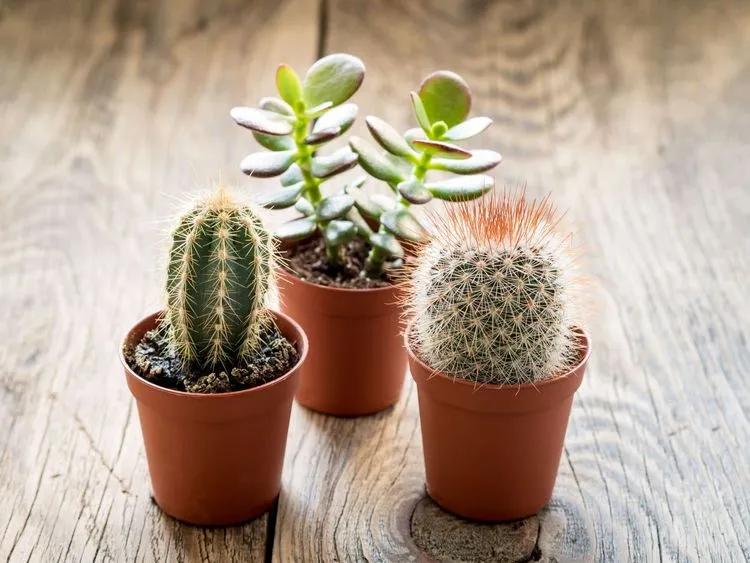 If you are a genuine plant lover, you must have questioned yourself at least once: “why do insects appear on a flower?” After all, it could seem that growing green pets indoors is a guarantee that no infection will harm it. Unfortunately, this is not the truth, and from time to time almost every home garden is exposed to the invasion of parasites.
If you are a genuine plant lover, you must have questioned yourself at least once: “why do insects appear on a flower?” After all, it could seem that growing green pets indoors is a guarantee that no infection will harm it. Unfortunately, this is not the truth, and from time to time almost every home garden is exposed to the invasion of parasites.
How can infection spread?
-
Open vents and windows. Flying insects easily fly through the vents and cracks in the window. Move plants to the open air during the warmer months.
-
Acquisition of an infected plant. Buying another beautiful plant, you may not notice the lurking pests, which begin to multiply rapidly in indoor conditions, spreading to nearby crops.
-
Transfer to a new substrate. Various insects often live in the soil taken from a garden or forest. At home, parasites, finding no other food, attack the plant. Unfortunately, some purchased soils are also infected with pests.
-
Care mistakes. Overflowing, underfilling, too dry or, conversely, humid air, insufficient or excessive lighting - all this weakens the plant. The resistance of the diseased organism decreases, and insects willingly take advantage of this, attacking the flower.
As you can see, there are enough ways for aggressors to enter the closed space of the apartment. Of course, in indoor conditions, pests affect plants much less often than in open ground, but if this happens, the fight against them turns into a real difficulty.
Consider the main pests of indoor plants that infect nearby plants, moving from one plant to another. All your plants can be damaged if pest control is not started in time.
The mealybugs
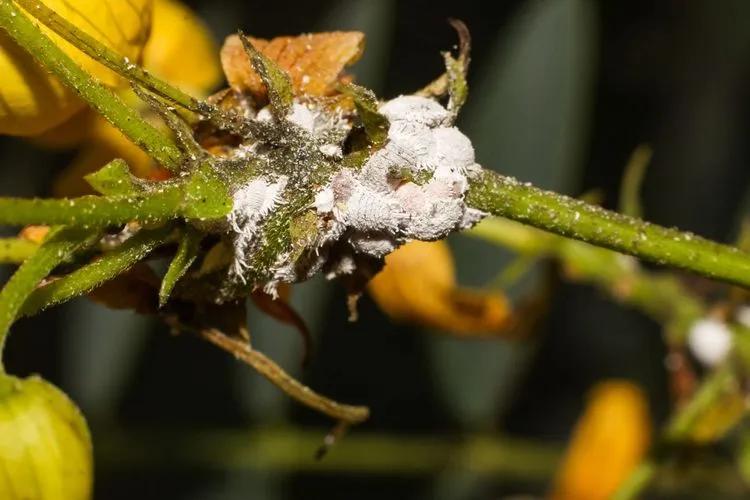 The mealybug or hairy louse is one of the most dangerous and common insects that attack house flowers. It differs in a wide variety of species: seaside, citrus, cactus, bristly, grape, root. These are large (up to 5 mm) insects with the bodies covered with a powdery powdery coating of white or cream shades. They are easy enough to notice: as a rule, pests get lost in colonies on leaves and shoots.
Mealybugs feed on plant sap and secrete a sweet liquid. The flower, attacked by the parasite, gradually withers, its leaves turn yellow and fall off, growth and development stops.
The mealybug or hairy louse is one of the most dangerous and common insects that attack house flowers. It differs in a wide variety of species: seaside, citrus, cactus, bristly, grape, root. These are large (up to 5 mm) insects with the bodies covered with a powdery powdery coating of white or cream shades. They are easy enough to notice: as a rule, pests get lost in colonies on leaves and shoots.
Mealybugs feed on plant sap and secrete a sweet liquid. The flower, attacked by the parasite, gradually withers, its leaves turn yellow and fall off, growth and development stops.
The root bug
The root mealybug is even more dangerous than the abovementioned insect. If its fellows are easy to find on leaves and stems, then this type of hairy louse settles underground, on the roots. The plant, at first glance, withers for no reason, and its bewildered owner is trying to take any rescue measures by increasing watering or feeding.
This pest, perhaps, can be called omnivorous. No houseplant is immune to attack. Orchids, ficuses, violets, asparagus and even prickly cacti can be attacked by hairy lice. Moreover, if indoor flowers stand close to each other, the insect will easily move to another plant and find itself a new food source. That is why it is necessary to fight the mealybug immediately, without delaying even for a minute, especially since it is much easier to remove single parasites than numerous families.
The scale insect
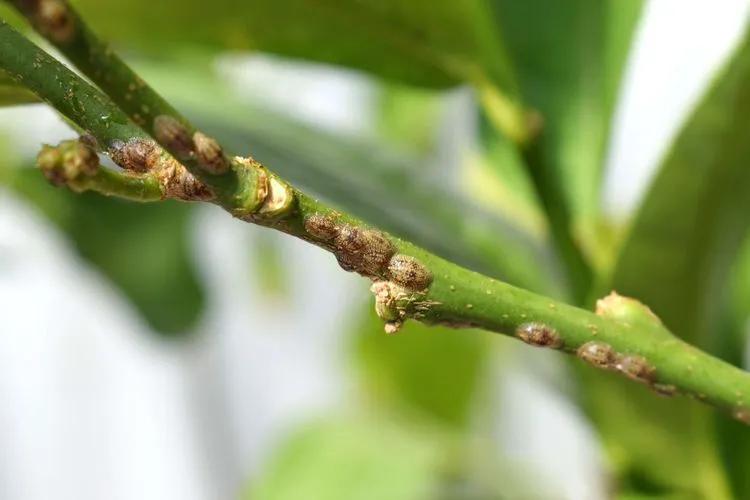 The scale insect is a common and rather dangerous pest, especially since novice growers often do not understand that they are dealing with parasites, mistaking insects for growths on the trunk and shoots. A dense chitinous carapace, the color of which varies from light, cream, to dark brown, helps the scabies mask. The size of adults can reach 4 mm. A large number of species of scale insects are known: orange, orange, olive, cactus, palm, ivy, euonymus, which, as the names suggest, prefer to settle on certain plants.
The scale insect is a common and rather dangerous pest, especially since novice growers often do not understand that they are dealing with parasites, mistaking insects for growths on the trunk and shoots. A dense chitinous carapace, the color of which varies from light, cream, to dark brown, helps the scabies mask. The size of adults can reach 4 mm. A large number of species of scale insects are known: orange, orange, olive, cactus, palm, ivy, euonymus, which, as the names suggest, prefer to settle on certain plants.
These insects stick to leaves or shoots, extracting all the nutrients from them; and not only adults, but also young larvae harm. The plant cannot regain strength, turns yellow and withers, and in especially poor cases dies.
As in the case of the mealybug, a fungus grows on the micro-wounds formed from insect bites, which additionally harms the flower. Perhaps not a single houseplant can withstand the invasion of the aggressor, and the insect often settles not only on leaves and stems, but also on the fruits of exotics (lemon, calamondin, kumquat). It is impossible to postpone the fight against the pest; measures should be taken immediately to save the green pet. The scale insect can successfully infect all nearby plants.
The spider mites
Unlike the previous species, spider mites are tiny insects, the limiting size of which is 1 mm. Ticks are often invisible to the naked eye, but they are betrayed by the silvery cobweb appearing on the leaves, shoots and other parts of the plant, and light puncture points on the leaves. There are plenty of species of spider mites that can settle on an indoor plant: ordinary, red, pacific, however, they almost do not differ from each other.
The saddest thing is that a tick, once caught on a plant, is almost impossible to remove completely, some part of the population will remain in the soil and appear as soon as the green pet weakens. Some indoor species with succulent leaves are especially susceptible to the mite, for example, all domestic citruses, mini-roses in pots, and ficuses. However, any domestic culture, regardless of species, can become infected. You should fight the spider mites right away, at the first signs of danger, this is the only way to save the diseased plant from death.
Thrips
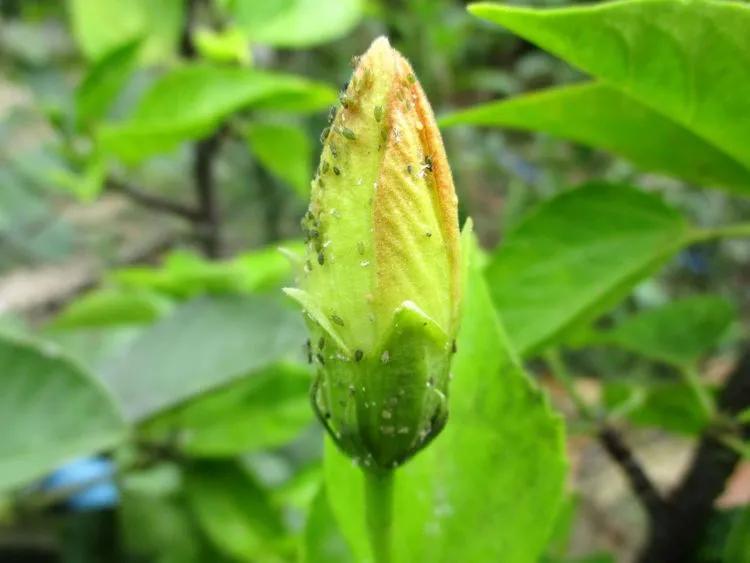 Along with mealybugs, scale insects and spider mites, thrips lead the charts of the most common parasites of domestic plants. Such popularity is not surprising, they can be seen everywhere: in the forest, in the meadow, they even live on vegetables and berries in supermarkets. Moving from plant to plant, thrips actively migrate, devouring all the greens in their path.
Along with mealybugs, scale insects and spider mites, thrips lead the charts of the most common parasites of domestic plants. Such popularity is not surprising, they can be seen everywhere: in the forest, in the meadow, they even live on vegetables and berries in supermarkets. Moving from plant to plant, thrips actively migrate, devouring all the greens in their path.
Aphids
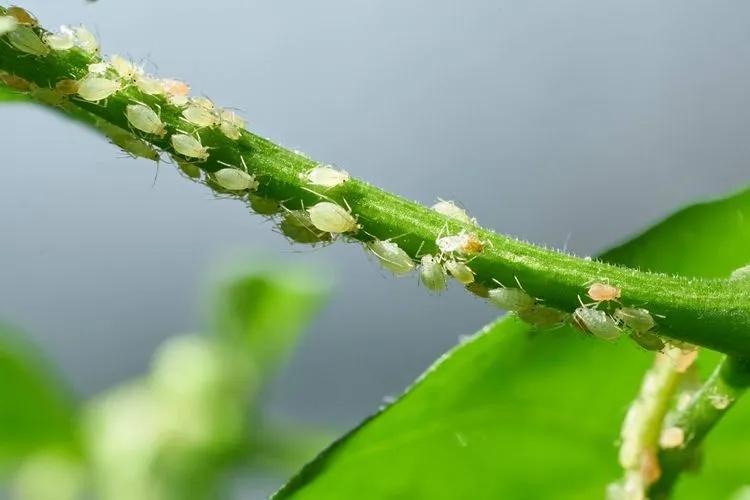 Aphids infecting indoor plants are not very common. A large (up to 2 mm) greenish insect is clearly visible even with the naked eye. The main part of the colony is wingless with a thick translucent belly and thin, long legs and antennae. However, there are also flying specimens, the main task of which is to mate and capture neighboring territories.
These parasites, like other pests, feed on plant sap, piercing green shoots and leaves with a sharp proboscis. At the site of punctures, light dots of dead tissue are formed.
Aphids infecting indoor plants are not very common. A large (up to 2 mm) greenish insect is clearly visible even with the naked eye. The main part of the colony is wingless with a thick translucent belly and thin, long legs and antennae. However, there are also flying specimens, the main task of which is to mate and capture neighboring territories.
These parasites, like other pests, feed on plant sap, piercing green shoots and leaves with a sharp proboscis. At the site of punctures, light dots of dead tissue are formed.
Whiteflies
 Its beautiful name is used to refer to a dangerous and very unpleasant insect that harms green spaces. For indoor crops, the greenhouse whitefly is especially dangerous - a medium-sized (up to 3 mm) flying yellowish moth. Its body and wings are covered with a white powdery coating, and, in general, the insect resembles a moth.
Its beautiful name is used to refer to a dangerous and very unpleasant insect that harms green spaces. For indoor crops, the greenhouse whitefly is especially dangerous - a medium-sized (up to 3 mm) flying yellowish moth. Its body and wings are covered with a white powdery coating, and, in general, the insect resembles a moth.
Summarizing tips:
- If you can find any insect pests on your plant, isolate it from the rest by quarantining. If this is neglected, all the other flowers standing nearby will soon become infected.
- All newly purchased plants must also be fenced off from the rest. Even if the parasites are not visible, the flower may be infected and symptoms of infection will appear later.
